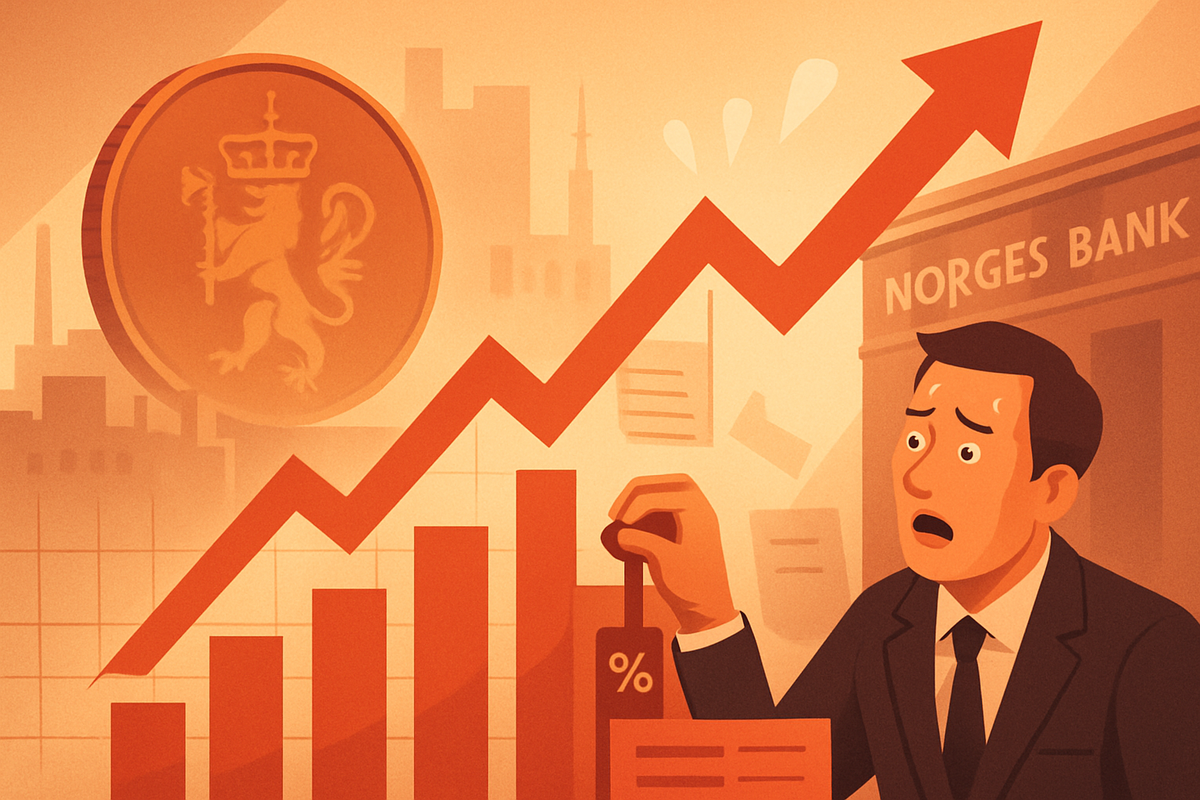
Oslo, Norway – October 10, 2025 – Norway's economic landscape has been jolted by an unexpected surge in its annual inflation rate, which climbed to 3.6% in September 2025. This unanticipated rise, reported today, marks a significant increase from August's 3.5% and represents the highest level since February of this year, catching market analysts off guard. The surprise inflation figure immediately casts a hawkish shadow over Norges Bank's carefully laid plans for monetary easing, complicating its efforts to steer the economy towards its 2% inflation target.
The development poses a critical challenge for the central bank, which had already initiated a cautious loosening cycle earlier in the year. This unexpected acceleration in price growth now forces Norges Bank to reassess its trajectory, potentially delaying or moderating future interest rate cuts and injecting a new layer of uncertainty into the financial markets. Investors and businesses alike are now closely watching for Norges Bank's next move, as the path forward for Norway's monetary policy appears significantly less clear.
The Unforeseen Ascent: Details of Norway's Inflation Shock
The September 2025 inflation data revealed that the Consumer Price Index (CPI) rose by 3.6% year-on-year, surpassing market expectations which had largely settled on a more modest 3.5%. On a monthly basis, the CPI increased by 0.4%, also exceeding forecasts of a 0.3% rise. This broad-based price pressure was primarily driven by increases in the cost of food, non-alcoholic beverages, and transport. Interestingly, the core inflation rate (CPI-ATE), which strips out volatile energy prices and tax changes—a metric closely watched by Norges Bank—showed a slight moderation, rising 3.0% year-on-year, marginally below the 3.1% forecast. While this offers a sliver of relief, the headline figure's strength cannot be ignored.
The timeline of Norges Bank's recent actions underscores the dilemma. The central bank had been on a path of gradual easing, having cut its policy rate from 4.5% to 4.25% in June 2025. After pausing in August, it further reduced the policy rate to 4% just before the release of this latest inflation data. This pre-emptive easing was based on expectations of moderating inflation. Key players in this unfolding narrative include Norges Bank itself, which now faces increased scrutiny, as well as market analysts and investors who are scrambling to recalibrate their expectations. Initial market reactions have been nuanced; while some acknowledge the core inflation dip, the overall sentiment points to a re-evaluation of the certainty and timing of future rate cuts. The unexpected inflation complicates Norges Bank's guidance and its commitment to a "cautious normalisation" of monetary policy.
Corporate Crossroads: Winners and Losers in a High-Inflation Environment
The persistence of higher-than-expected inflation and the potential for a prolonged period of elevated interest rates in Norway will inevitably create a bifurcated impact across public companies, favoring some sectors while challenging others.
Potential Winners: Norwegian banks, such as DNB Bank ASA (OSE: DNB) and Storebrand ASA (OSE: STB), have generally seen improved net interest margins and profitability as interest rates have risen. A "higher-for-longer" rate environment could continue to bolster their earnings, provided loan losses remain contained. Similarly, Norway's energy sector, particularly major oil and gas producers like Equinor ASA (OSE: EQNR), Aker BP ASA (OSE: AKERBP), and Vår Energi ASA (OSE: VAR), often benefits from higher global energy prices, which contribute to inflation. A weaker Norwegian Krone (NOK), which can result from interest rate differentials, also boosts their NOK-denominated revenues as oil and gas are priced in USD. Export-oriented industries, including certain manufacturing and shipping companies, may also find some advantage in a weaker NOK, making their goods more competitive internationally.
Potential Losers: The real estate and construction sectors are among the most vulnerable. Companies like construction giant AF Gruppen ASA (OSE: AFG) face significantly higher financing costs, as bank lending rates have surged. Higher mortgage rates also dampen housing demand, potentially leading to reduced property values and transaction volumes, which could impact larger real estate issuers such as Bane Nor Eiendom AS and Obos Eiendom AS. The retail sector, especially those focused on consumer discretionary spending, is also at risk. High inflation eradicates consumer purchasing power, while higher interest rates on mortgages leave households with less disposable income. This combination can lead to reduced spending on non-essential goods and squeeze profit margins for retailers. Companies with high debt levels and those unable to pass on rising input costs to consumers will face significant headwinds.
Wider Ripples: Norges Bank's Credibility and Nordic Stability
Norway's unexpected inflation surge carries broader implications that extend beyond its borders, impacting Norges Bank's credibility, the stability of the wider Nordic region, and potentially challenging established economic models.
For Norges Bank, the persistent inflation, despite earlier rate cuts, puts its forecasting capabilities and policy guidance under scrutiny. Like many central banks globally, Norges Bank has faced challenges in accurately predicting inflation's trajectory. This unexpected rebound complicates its communication strategy and the market's ability to anticipate future moves, risking increased exchange rate volatility if confidence in the central bank's ability to anchor inflation expectations wanes. A weaker Norwegian Krone, fueled by policy uncertainty, could further exacerbate imported inflation, creating a difficult feedback loop.
Across the Nordic region, Norway's inflationary pressures are a reminder of shared vulnerabilities. All Nordic countries experienced significant price increases post-2021, driven by global energy and food costs. While some, like Sweden, have seen inflation ease below 2% and prompted policy easing from the Riksbank, Norway's stickier inflation could lead to a divergence in monetary policy paths within the region. This divergence can affect currency crosses, trade dynamics, and capital flows. Historically, Norway has contended with periods of high inflation, notably in the 1970s and 80s, which necessitated stringent measures like aggressive rate hikes and fiscal tightening. The central bank's current dilemma echoes these past challenges, emphasizing the delicate balance between price stability and economic growth. The ability of Norges Bank to provide clear, consistent communication will be paramount in navigating this complex environment and preventing wider regional contagion.
The Path Ahead: Scenarios for Norges Bank and Market Adjustments
Looking forward, Norges Bank faces a critical juncture, with several potential scenarios for its monetary policy and subsequent impacts on the Norwegian market. The short-term outlook (late 2025 - early 2026) is dominated by the need to assess the persistence of inflation.
Short-Term Possibilities: A period of holding the policy rate at 4.0% is highly probable in the immediate future. This "wait-and-see" approach would allow Norges Bank to scrutinize incoming economic data, particularly if headline inflation remains sticky. While the central bank's latest projections imply a gradual easing, the September inflation surprise and a persistently weak Norwegian Krone limit aggressive cuts. Some analysts anticipate the next 25 basis point cut might be delayed until January 2026, rather than late 2025.
Long-Term Possibilities (2026 and Beyond): Norges Bank's long-term projections, as of September 2025, suggest a gradual decline in the policy rate to around 3% by the end of 2028. This "cautious easing" scenario assumes inflation gradually converges to the 2% target and unemployment rises slightly. However, if inflation proves more persistent, driven by strong wage growth or resilient household consumption, Norges Bank might delay or reduce the number of planned rate cuts. Conversely, a faster easing scenario could materialize if domestic demand softens more than expected or if global disinflationary pressures intensify. A less likely, but not impossible, scenario is a resumption of rate hikes if inflation significantly re-accelerates and the Norwegian Krone weakens dramatically.
Market Opportunities and Challenges: For investors, opportunities may emerge in Norwegian government bonds if Norges Bank eventually moves towards a more accommodative stance. The real estate market, after a period of adjustment, is also poised for recovery in 2025, supported by stabilizing interest rates and rising real disposable incomes. Export-oriented sectors could continue to benefit from a weak NOK. However, challenges include potential underperformance of Norwegian equities if easing is protracted, erosion of real returns by persistent inflation, and continued NOK volatility. Investors should closely monitor Norges Bank's upcoming communications and economic data releases for clearer signals.
Conclusion: Navigating the Inflationary Crosscurrents
Norway's unexpected inflation jump to 3.6% in September 2025 marks a significant pivot point, fundamentally altering the short-term outlook for Norges Bank's monetary policy. The key takeaway is that the path to easing will be more protracted and uncertain than previously anticipated, challenging the central bank's credibility and forcing a recalibration of market expectations. While core inflation offered a glimmer of hope, the headline figure's resilience underscores the persistent inflationary pressures within the Norwegian economy.
Moving forward, the market will be keenly focused on Norges Bank's next policy meetings and its updated economic projections. Investors should prepare for a "higher-for-longer" interest rate environment, at least in the near term, which will continue to benefit the banking and energy sectors while posing challenges for real estate and consumer discretionary retail. The interplay between domestic inflation, global economic trends, and the Norwegian Krone's strength will dictate Norges Bank's future actions. The lasting impact of this inflation surprise will be seen in the central bank's ability to guide the economy back to its target without stifling growth, making the coming months crucial for Norway's financial markets.
This content is intended for informational purposes only and is not financial advice





